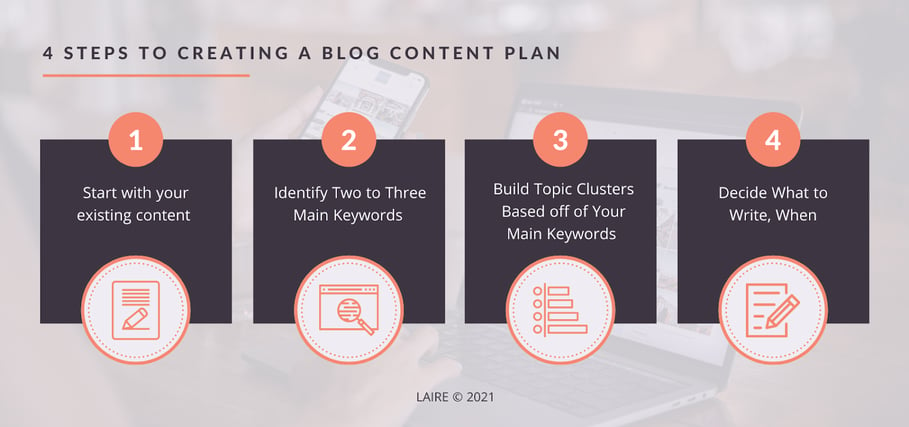To get your message out there and attract visitors to your website, you need content. Content creation is a day-in and day-out task that requires careful planning and attention to ensure top-quality work that aligns with your business’ content strategy. However, if you’re already struggling to fill your publishing queue, planning content can often feel like a daunting and defeating task. We don’t want to write blog articles just to meet a deadline or fill an empty gap on an editorial calendar. Your content should be purposeful. One way to ensure purpose and quality in your content production is by planning ahead. In this article, we will outline the steps you can take to plan out six months of content in less than 30 minutes.
Before you dive in, we highly recommend that you utilize some type of editorial calendar. Keep in mind that your editorial calendar and content plan are two different things. Your content plan will inform how you fill the holes within your editorial calendar. At LAIRE, we use a Google spreadsheet to keep track of our blog content. Determine a reasonable blog cadence for your business and begin building out the framework of your calendar. For example, if you want to publish four blogs per month, create four rows in your spreadsheet to allocate for the blog titles that you would like to produce within that month.
From there, you can create columns for the due date, publish date, author, blog topic/title, target keywords, target persona, associated offer/CTA, creative brief, and status, for example. Find a system that works for you and agrees with your internal processes. Feel free to make changes as you go once you discover how the calendar framework works for you. Now that you have the structure, let’s jump right into how you can fill your calendar with 6 months worth of awesome content.
4 Steps to Creating a Blog Content Plan

1. Start With Your Existing Content
The first step is to take an inventory of the various types of content that already exist on your website. Create a library of what you have so that you can determine what is needed. This is also a good time to review the older pieces that may be due for an update. We like to call this process ROPS. ROPS is an acronym that stands for rework, optimize, publish, and share. This is a good strategy for repurposing your existing content and making changes that will increase its value and reach. It’s a process of reusing and recycling to keep your content fresh without having to start from scratch.
Chances are, you have some good content that can be transformed in a way that will work smarter for you without losing it completely. You can identify blogs that are ready to ROPS by reviewing views, impressions, and clicks on any analytics platform. If you notice a significant drop in any of those metrics on a blog that is older than six months, make a note of the blog title. Any instances of less than ideal performance can be great opportunities for a ROPS. You want to have a mix of ROPS content and new original blog content as part of your content plan. Once you’ve identified the pieces that could use a refresh, space them out on your editorial calendar.
2. Identify Two to Three Main Keywords
If you don’t already have keywords that your business is targeting, now is the time! A good place to start is with your elevator pitch. By this we mean, what is the 30-second summary that you give when you are explaining who you are and what you do? Think of the main describing words that you would typically use to describe your business and pull those out as keywords. Your keywords should be the main identifiers of your business that an individual would use to search for your service or product offerings. For example, a builder might use the keywords, ‘custom home builder’, ‘home remodeling’, or ‘home improvement’.
After you jot down your main keywords, you can create a list of sub-keywords that branch off from them. There is no limit to the number of sub-keywords you can have. Back to our previous builder example, if ‘custom home builder’ is the main keyword, a few sub-keywords might be: ‘custom home floor plan’, ‘renovations’, ‘luxury neighborhoods’, or ‘custom home design process’. By utilizing keyword research tools, you can determine the search volume and difficulty of each term to decide how successful your choices will be. A few options to look into are Google Trends, Free Keyword Generator, Wordtracker, Keyword Explorer from Moz, or Ubersuggest. Of course, there are paid options out there as well, such as SEMrush or Serpstat.
3. Build Topic Clusters Based Off Of Your Main Keywords
Now that you have a solid set of main keywords and sub-keywords, it’s time to begin forming blog topics. The recommended model we are suggesting here is referred to as a topic cluster. Each of your main keywords will be separate core topics. Your sub-keywords will be the guide for your blog topics and titles, nested underneath the core topic which then builds your cluster of content.
The key is to ensure that you are using your main keywords and sub-keywords in your blog titles to begin gaining authority for the subject. Do make sure that each of your articles brings something unique to the topic. Let’s say one of your main keywords is ‘pet ownership’. Your topic cluster might involve sub-keywords such as ‘nutrition’, ‘supplies’, ‘health’, ‘training’, or ‘grooming’. From here, you can see how topics will start to evolve:
- Nutrition Insights that Pet Owners Should Pay Attention To
- Top X Supplies Needed for First Time Pet Ownership
- X Reasons Why Pet Ownership Leads to Better Mental Health
- X Proven Methods of Training Your Pet
- Grooming Tips for New Pet Owners
4. Decide What to Write, When
Now that you have a handful of topics related to your main keywords, you just need to decide what you will write, when. Some titles may be better suited as a seasonal subject, so be sure to schedule those appropriately in your editorial calendar. If your business has a certain time of year when you are pushing a specific product, schedule topics that will support the internal strategies of your sales team. Otherwise, if you don’t have hard dates for seasonal topics, then begin placing your topics within the framework of your editorial calendar. You should now see gaps being steadily filled with fresh blog topics.
Winning Blog Planning Tips
The best way to approach your calendar is with fluidity. Remember that things will shift as needs arise. We recommend building room for buffer content in the case that circumstances do change. This way, you won’t be thrown off if you end up having to scratch one title at the last minute. Try to get several weeks ahead of your writing schedule to avoid scrambling on the week that a blog is set to publish.
Next, divide up responsibilities appropriately to decide who will be writing each of your articles. What can your team write in-house? Will you need to outsource the blog to a freelance writer? Does the topic require input from a subject matter expert? Clarify roles and expectations as early as you can for better success in execution. Assess your content’s performance regularly to see what is being well-received by your target audiences and what may require some additional finessing. These insights will help you to identify topics that you can continue building quality content around.
Conclusion
In no time you’ll have six months worth of content queued up and ready to go. At LAIRE, we build comprehensive content marketing strategies designed to engage your target audience and nurture them through the buyer’s journey. We know what it takes to optimize your content with the right keywords that will increase your website traffic and generate new leads for your business. To take the next step in your planning process, download our free blog templates designed for winning engagement.


